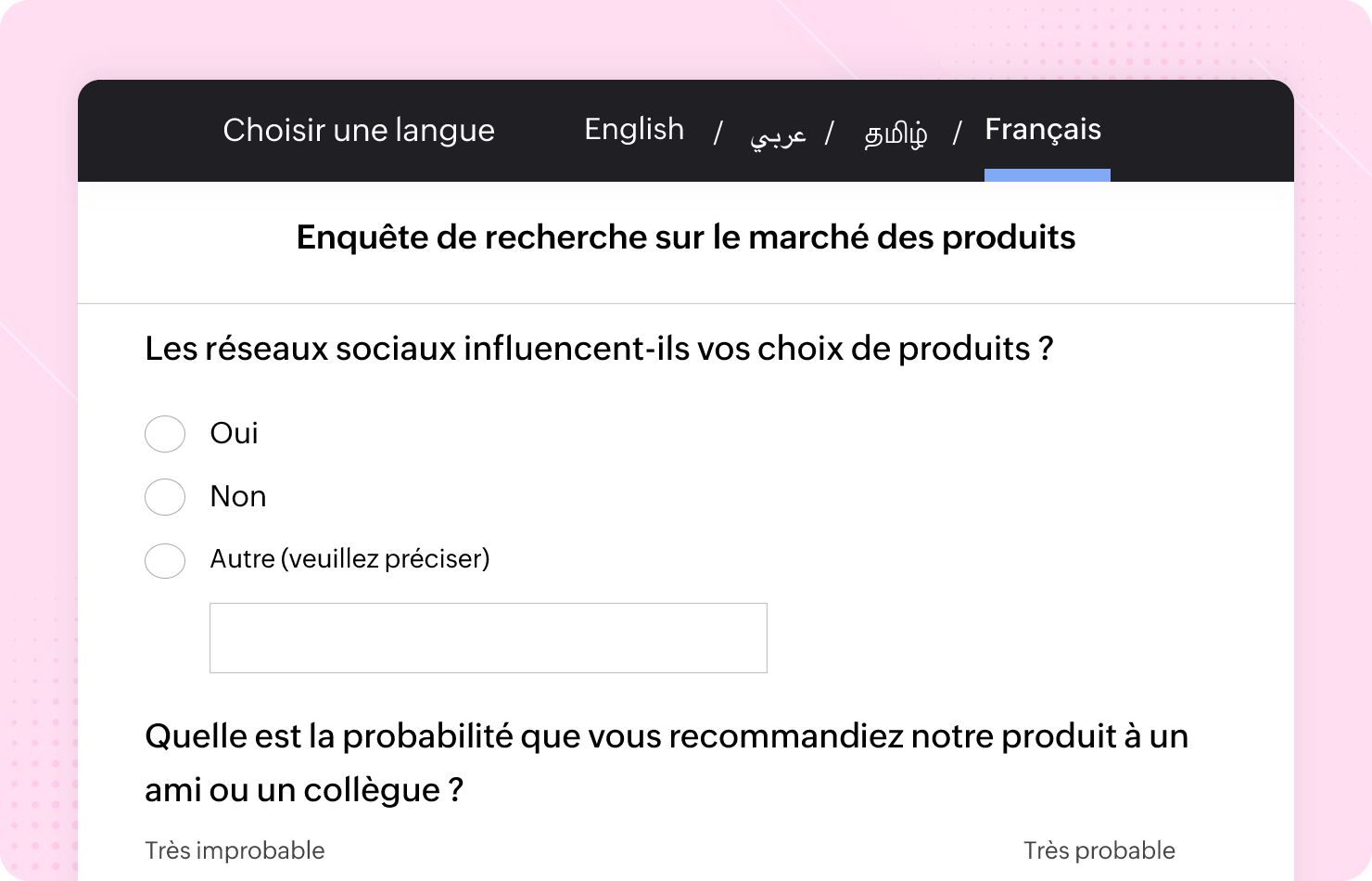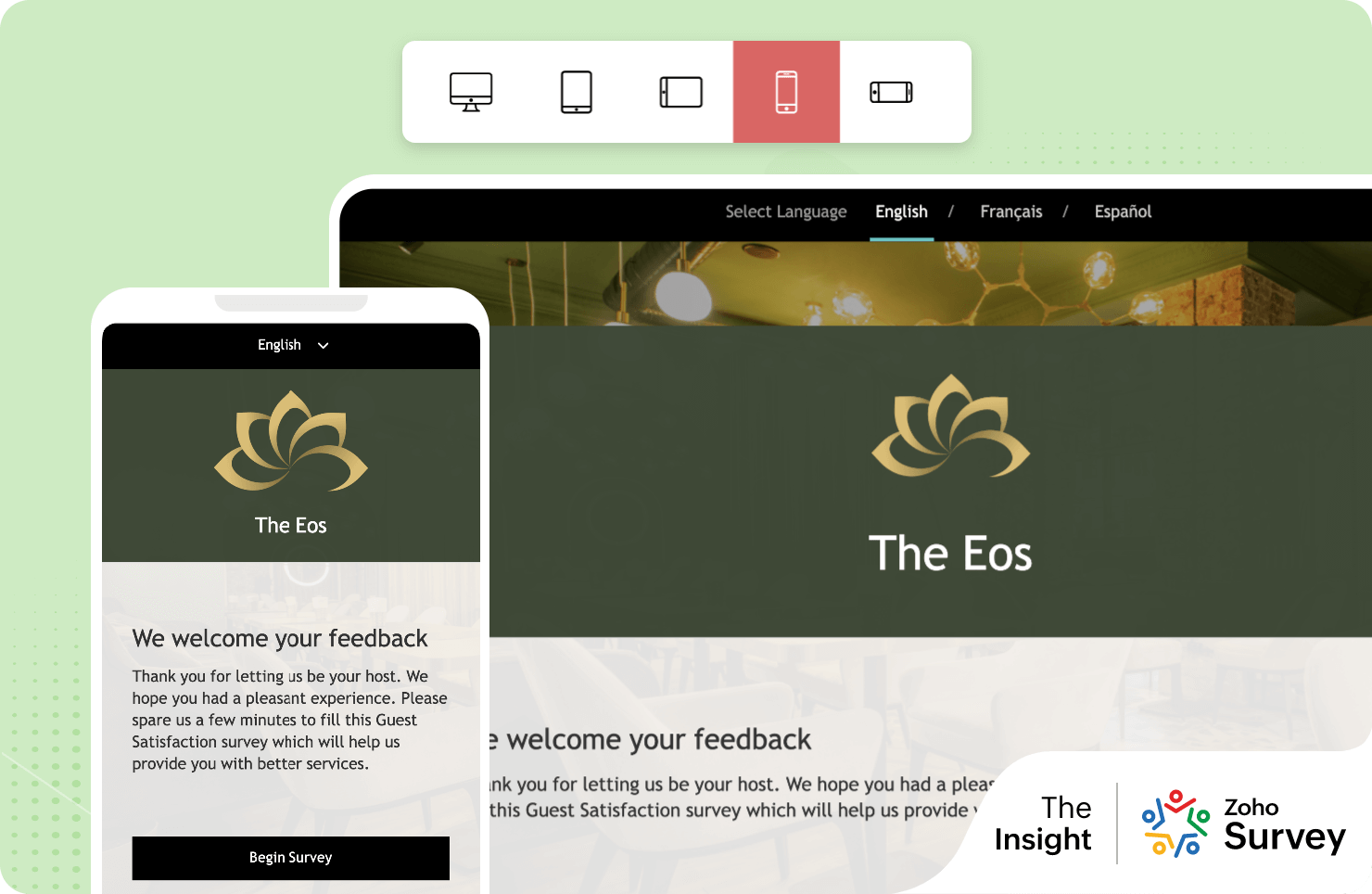1. Multilingual surveys: Bridging language gaps

To collect insights and feedback from diverse demographics, present survey questions in multiple languages. This approach enables global participation by allowing respondents to engage in their preferred language comfortably. Promoting inclusivity through language also helps increase your response rates.
This concern is particularly vital for multinational companies and researchers seeking comprehensive data. They help organizations understand cultural nuances, preferences, and opinions among different linguistic groups to ensure more accurate insights for informed decision-making.
2. Clarity matters: Crafting clear and simple surveys
Ensure your survey is easy to comprehend and navigate. This can be done by incorporating a clear header, footer, survey introduction, terms and conditions page, and end page. Your survey should use clear and simple language, avoid technical terms, and have a clean layout to ensure easy communication with your audience. A user-friendly interface greatly enhances the respondent experience.
3. Conversational surveys: Creating an engaging dialogue
Start by imagining your survey as a conversation and not just as a list of information you want to collect. Crafting surveys that emulate a conversational tone is an art form. Initiate by establishing an inviting and engaging tone. Encourage participant involvement by phrasing questions in a conversational style. When the survey reflects a friendly chat, participants feel more comfortable, resulting in more candid and thoughtful responses.
4. Curiosity-driven questions: Stimulating engagement
One key to ensuring participant comfort is to ask questions that pique their interest. Aim for questions that spark curiosity, making participants eager to share their thoughts. When questions are stimulating, individuals are more inclined to invest time and effort in offering thoughtful responses to your surveys.
5. Respecting privacy: Establishing boundaries
Zoho puts a high priority on protecting individual privacy and safeguarding the data submitted by survey participants. We actively discourage probing into personal or sensitive matters unless it is essential for business or research purposes.
Should such inquiries become necessary, they must be approached with utmost respect, accompanied by transparent explanations for why the information is necessary and how it will be used. By elucidating the reasons behind the need for personal data, we aim to establish a sense of ease and trust among participants. Additionally, opting for ranges instead of specific values can enable individuals to share information while preserving their privacy.
6. Strategic placement: Demographic questions
Demographic questions can sometimes seem intrusive and may make participants cautious. To address this, consider positioning these inquiries toward the end of the survey. By doing so, participants will have already engaged with the questionnaire, and they might feel more at ease sharing personal details after they have already completed the rest of the survey. This approach can encourage greater comfort and willingness to provide demographic information.
7. Sensitive topics: Reducing discomfort
Addressing sensitive questions in surveys can be a challenge. To navigate this, strategically place these inquiries between non-threatening or neutral questions. This gradual approach helps participants ease into potentially uncomfortable topics, creating a smoother transition and reducing the risk of survey abandonment due to discomfort.
8. Striking a balance: Minimizing mandatory questions
Reduce the count of obligatory questions in your survey. An excessive series of mandatory inquiries may overwhelm participants, potentially causing them to abandon or hastily provide inaccurate responses. Opt for a minimal number of required questions, strategically placing them at regular intervals throughout your survey. Respecting the time and attention of your participants is crucial.
9. Depth in responses: Moderating open-ended questions
While open-ended questions can elicit unconventional insights from respondents, they must be used carefully. Numerous open-ended questions can cause fatigue among respondents, potentially causing dropouts. To mitigate this, intersperse a few open-ended questions strategically throughout the survey or use them at the end of each section to prompt participants to share their thoughts freely. This balanced approach allows for nuanced, detailed responses that offer insights beyond what multiple-choice questions may capture.
10. Mindful timing and length: Balancing survey duration
Attention spans have evolved, emphasizing the need to promptly engage survey participants and gather necessary insights efficiently. Simultaneously, it’s crucial to value participants’ time by keeping surveys succinct. Lengthy surveys can induce fatigue, which impacts the quality of responses. Consider breaking down extensive surveys into manageable sections or incorporating progress indicators to manage participant expectations and maintain engagement.
11. Quantity control: Managing survey load
Similar to limiting the length of your surveys, it’s crucial to restrict the number of surveys sent to participants. Bombarding them with an excessive number of surveys can result in fatigue and disengagement. Prioritize quality over quantity to ensure each survey serves a distinct purpose and sustains participant engagement. This approach respects participants’ time and attention, fosters better responses, and maintains interest in future survey opportunities.
12. Accessible anywhere: Mobile-friendly survey platforms

Mobile internet access has become an integral aspect of our lifestyle. It’s crucial to ensure your surveys are accessible across different devices, particularly mobile phones. A mobile-friendly interface empowers participants to take your survey at their convenience, whether they’re commuting on public transport or attending a concert. This ensures a comfortable survey experience to accommodate respondents’ diverse schedules and preferences.
13. Gratitude and follow-Up: Showing appreciation
Gathering insights extends beyond mere data collection; it’s equally essential to express gratitude to participants for their contribution. Consider showing appreciation through thank-you messages or by offering incentives such as discount coupons. In some cases, you may also want to share a summary of the survey results or insights to highlight the value of users’ input.
14. Feedback encouragement: Utilizing the comments box
Finally, concluding your survey with a comments box allows you to encourage participants to share additional insights, suggestions, or feedback for improvement. With this information, you can analyze responses, recognize recurring patterns, and implement changes for a more positive experience. This comments section enables participants to express opinions or elaborate on their responses, fostering a sense of contribution and value, ultimately contributing to ongoing improvement.
To sum it up, ensuring respondent comfort in surveys is an art that requires a blend of engagement, empathy, and respect. Prioritizing their comfort enriches data and builds rapport by fostering an environment where participants feel valued, recognizing that each response represents a person. Implementing these strategies will help you prioritize comfort, encourage genuine feedback, and boost participation to capture richer data and deeper insights.


